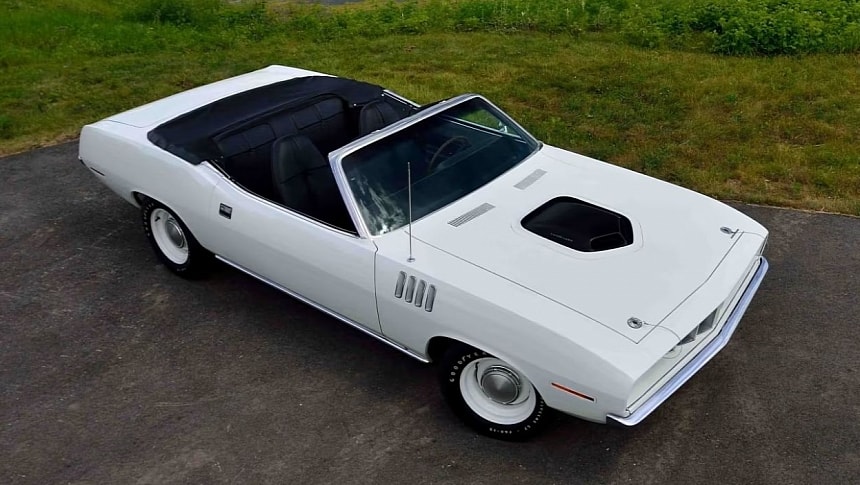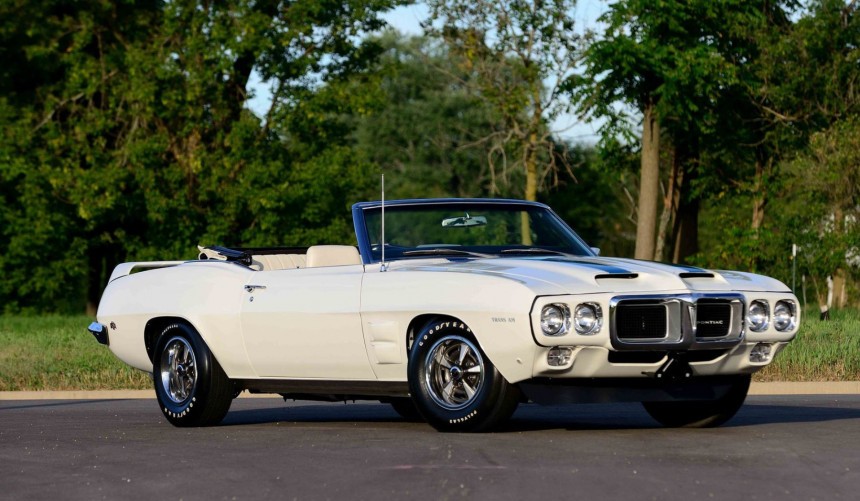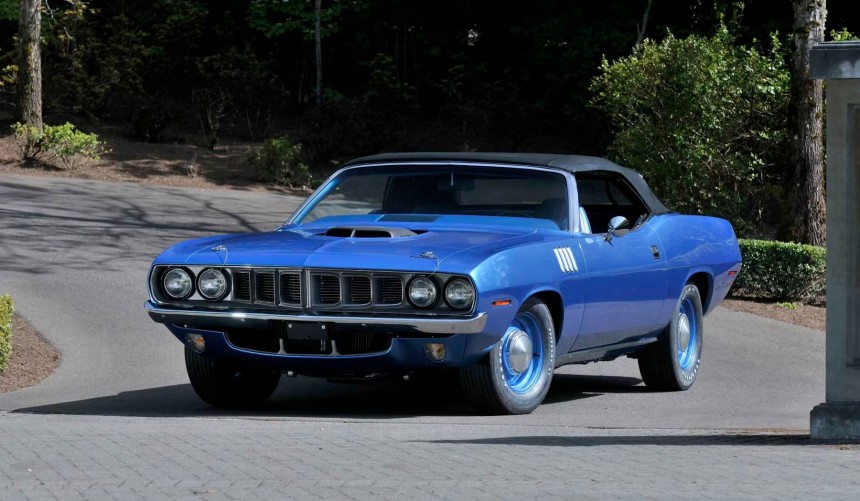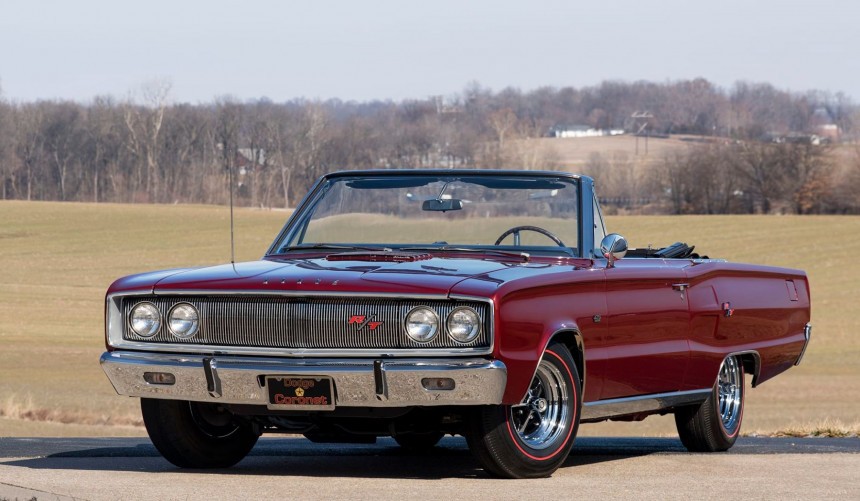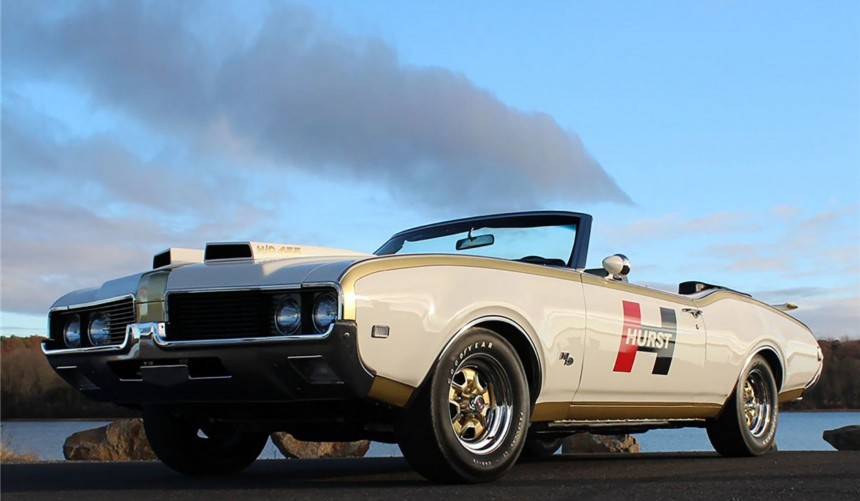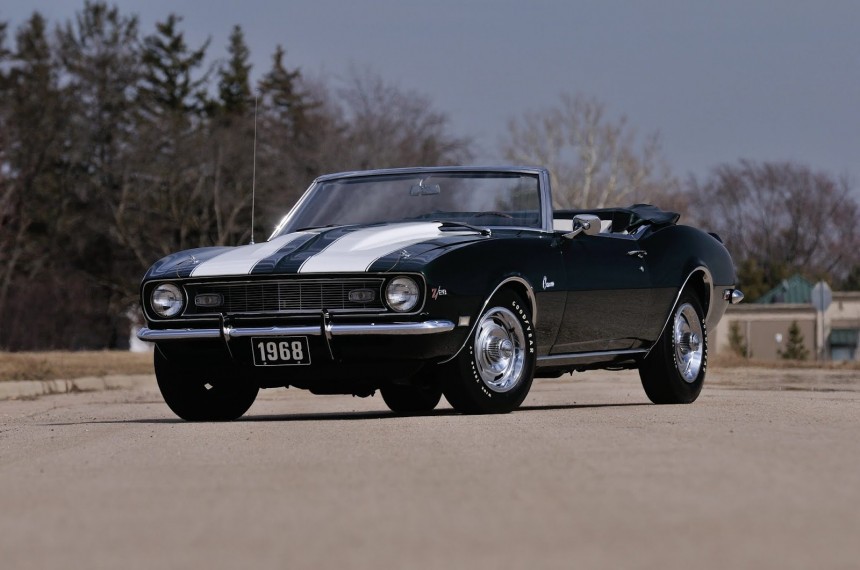During the second part of the 1960s and the early 1970s, tire-shredding muscle cars roamed the roads. While the vast majority were two-door coupes, some enthusiasts preferred the open-top feeling, and there were several models to choose from. However, some of those convertible muscle cars were so rare that they didn't even exceed double-digit production numbers.
Though transplanting a big and powerful V8, usually reserved for large, full-size models, into the engine bay of intermediates was nothing new, it really became a trend during the mid-1960s.
The Pontiac GTO is credited with kickstarting the muscle car craze in 1964 when it exceeded even the most optimistic sales predictions.
Most 1964 GTOs and the other muscle cars that followed were purchased in hardtop or fastback guses, but many of those models, including the 1964 GTO, were also available as convertibles.
Even though manufacturers strengthened the chassis of those drop-top versions and offered the same performance hardware, enthusiasts concerned about rigidity issues (and the slightly higher price) avoided them.
Generally speaking, convertible muscle cars are rarer than their hardtop counterparts and, in the case of the following five models, their production numbers stood in single-digit territory.
The Firebird and its GM F-body sibling, the Camaro, were launched in 1967 to lure in buyers from the pony car segment, which Ford and its iconic Mustang dominated.
Although they arrived a bit late, both the Firebird and Camaro quickly became worthy rivals for the 'Stang, thanks to their design and wide range of options, including powerful V8s.
For the 1969 model year, the first-gen Firebird was revamped for one last time, but the biggest news was the introduction of the Trans Am package in March of that year.
Available for the range-topping Firebird 400, the package added a host of performance upgrades, including an L74 400-ci (6.6-liter) Ram Air V8.
Rated at 335 hp in standard form or 345 hp when equipped with the Ram Air IV option, the engine plus the other upgrades that came with the Trans Am package transformed the Firebird into a legitimate muscle car.
Due to its late introduction and steep price, the first-ever Trans Am was produced in just 697 examples. The vast majority were hardtops, but eight were ordered as convertibles.
Today, all eight are still around and their value comfortably exceeds the $1,000,000 mark. The example pictured above fetched no less than $1,500.000 at a Mecum auction in 2016.
However, the Valiant-derived two-door fastback was no match for the Mustang, which outsold its main rival by a large margin.
Plymouth tried its best to fight back by improving the Barracuda in 1965 and 1966, but to no avial. In 1967, a completely redesigned model was introduced and although it was more succesful than its predecesor, it still couldn't pose a real challenge for the Mustang.
The Chrysler division didn't give up on its pony car, and in 1970, it launched the third-generation 'Cuda, which now had a large enough engine bay to accommodate Chrysler's most powerful big-block V8s, including the mighty 426 HEMI.
With the Elephant engine under the hood, the HEMI 'Cuda became one of the most lethal factory-built muscle cars during the 1970 and 1971 model years.
The vast majority of HEMI 'Cudas were sold in hardtop guise, but a (very) few enthusiasts brought convertibles. The lowest production number came in 1971 when only 7 drop-top examples were built.
Like the 1969 Trans Am convertible, a surviving 1971 HEMI 'Cuda convertible is insanely expensive. The blue example shown above was sold by Mecum in 2014 for $3.85 million.
In 1967, the final year for the fifth-generation Coronet, Dodge introduced the R/T trim, which turned the two-door versions of the intermediate into thoroughbred muscle cars.
Available either as a hardtop or convertible, the Coronet R/T came standard with chassis enhancements, and the 375-hp, 440-ci (7.2-liter) Magnum big-block V8, while those who wanted more power could get the optional 425-hp, 426-ci (7.0-liter) HEMI.
The Elephant engine was an expensive option, so few 1969 Coronet R/T's left the factory with one under the hood. Those that did, were mainly hardtops, while just 3 HEMI-powered convertibles were built.
In 1968, the Coronet was completely redesigned, but those equipped with the R/T trim were still available as two-door hardtops or convertibles with the HEMI available once again.
Until the end of the 1970 model year, when the fifth-gen Coronet was discontinued, the R/T HEMI convertible continued to be a rare choice among buyers. That year, the record-low of 3 units produced was equaled once again.
Today, an original 1967 or 1970 Coronet R/T HEMI convertible is worth seven figures.
Launched a few months after the Pontiac GTO, the Cutlass-based 4-4-2 was Oldsmobile's take on thoroughbred muscle. By 1966, it was the quarter-mile king of factory-built intermediates, but Olds was not done.
For the 1968 model year, the division's engineers figured out a way to bypass GM's self-imposed ban on V8s larger than 400 ci (6.55 liters) and created a beast.
Created in collaboration with Hurst Performance, the Hurst/Olds was basically a 4-4-2 with a unique appearance that left the Oldsmobile factory without an engine.
To bypass the abovementioned restriction, Hurst was in charge of installing the 455-ci (7.5-liter) Rocket V8, which made 390 hp.
The original Hurst/Olds was available during the 1968 and 1969 model years and was only sold as a two-door fastback coupe.
However, in 1969, Hurst converted three 442 convertibles to Hurst/Olds specifications for promotional purposes. One of the cars was damaged beyond repair in an accident, so Hurst built a third convertible.
Today, both cars have survived and are part of private collections, and their worth stands in seven-digit territory.
The brainchild of Vince Piggins, the model initially flew under the radar, as Chevy didn't run any marketing campaigns to promote it.
Nevertheless, those in the know were treated to a beefed-up Camaro that hid a high-output small-block 302-ci (4.9-liter) V8 initially designed for racing in the Trans-Am 5-litre (305 ci) class.
For homologation purposes, the engine was rated at 290 hp, but in reality, it made sensibly more, making the 1969 Camaro Z/28 a potent street fighter.
Only 7,199 Z/28s were built in 1968, and officially, all were hardtops. However, a single convertible was built for Chevy general manager Pete Estes through the COPO program.
The car survived, was restored, and changed owners several times. It remains the rarest, most sought-after Camaro ever built, so if it were to hit the auction block in the near future, it would probably shatter the HEMI 'Cuda convertible's record.
The Pontiac GTO is credited with kickstarting the muscle car craze in 1964 when it exceeded even the most optimistic sales predictions.
Most 1964 GTOs and the other muscle cars that followed were purchased in hardtop or fastback guses, but many of those models, including the 1964 GTO, were also available as convertibles.
Even though manufacturers strengthened the chassis of those drop-top versions and offered the same performance hardware, enthusiasts concerned about rigidity issues (and the slightly higher price) avoided them.
Generally speaking, convertible muscle cars are rarer than their hardtop counterparts and, in the case of the following five models, their production numbers stood in single-digit territory.
1969 Pontiac Trans Am Convertible
Although they arrived a bit late, both the Firebird and Camaro quickly became worthy rivals for the 'Stang, thanks to their design and wide range of options, including powerful V8s.
For the 1969 model year, the first-gen Firebird was revamped for one last time, but the biggest news was the introduction of the Trans Am package in March of that year.
Available for the range-topping Firebird 400, the package added a host of performance upgrades, including an L74 400-ci (6.6-liter) Ram Air V8.
Rated at 335 hp in standard form or 345 hp when equipped with the Ram Air IV option, the engine plus the other upgrades that came with the Trans Am package transformed the Firebird into a legitimate muscle car.
Due to its late introduction and steep price, the first-ever Trans Am was produced in just 697 examples. The vast majority were hardtops, but eight were ordered as convertibles.
Today, all eight are still around and their value comfortably exceeds the $1,000,000 mark. The example pictured above fetched no less than $1,500.000 at a Mecum auction in 2016.
1971 Plymouth HEMI 'Cuda Convertible
The Plymouth Barracuda was actually America's first pony car, having been introduced a few weeks earlier than the Ford Mustang.
However, the Valiant-derived two-door fastback was no match for the Mustang, which outsold its main rival by a large margin.
Plymouth tried its best to fight back by improving the Barracuda in 1965 and 1966, but to no avial. In 1967, a completely redesigned model was introduced and although it was more succesful than its predecesor, it still couldn't pose a real challenge for the Mustang.
The Chrysler division didn't give up on its pony car, and in 1970, it launched the third-generation 'Cuda, which now had a large enough engine bay to accommodate Chrysler's most powerful big-block V8s, including the mighty 426 HEMI.
With the Elephant engine under the hood, the HEMI 'Cuda became one of the most lethal factory-built muscle cars during the 1970 and 1971 model years.
The vast majority of HEMI 'Cudas were sold in hardtop guise, but a (very) few enthusiasts brought convertibles. The lowest production number came in 1971 when only 7 drop-top examples were built.
Like the 1969 Trans Am convertible, a surviving 1971 HEMI 'Cuda convertible is insanely expensive. The blue example shown above was sold by Mecum in 2014 for $3.85 million.
1967 & 1970 Dodge Coronet R/T HEMI Convertible
Available either as a hardtop or convertible, the Coronet R/T came standard with chassis enhancements, and the 375-hp, 440-ci (7.2-liter) Magnum big-block V8, while those who wanted more power could get the optional 425-hp, 426-ci (7.0-liter) HEMI.
The Elephant engine was an expensive option, so few 1969 Coronet R/T's left the factory with one under the hood. Those that did, were mainly hardtops, while just 3 HEMI-powered convertibles were built.
In 1968, the Coronet was completely redesigned, but those equipped with the R/T trim were still available as two-door hardtops or convertibles with the HEMI available once again.
Until the end of the 1970 model year, when the fifth-gen Coronet was discontinued, the R/T HEMI convertible continued to be a rare choice among buyers. That year, the record-low of 3 units produced was equaled once again.
Today, an original 1967 or 1970 Coronet R/T HEMI convertible is worth seven figures.
1969 Hurst Olds Convertible
For the 1968 model year, the division's engineers figured out a way to bypass GM's self-imposed ban on V8s larger than 400 ci (6.55 liters) and created a beast.
Created in collaboration with Hurst Performance, the Hurst/Olds was basically a 4-4-2 with a unique appearance that left the Oldsmobile factory without an engine.
To bypass the abovementioned restriction, Hurst was in charge of installing the 455-ci (7.5-liter) Rocket V8, which made 390 hp.
The original Hurst/Olds was available during the 1968 and 1969 model years and was only sold as a two-door fastback coupe.
However, in 1969, Hurst converted three 442 convertibles to Hurst/Olds specifications for promotional purposes. One of the cars was damaged beyond repair in an accident, so Hurst built a third convertible.
Today, both cars have survived and are part of private collections, and their worth stands in seven-digit territory.
1968 Chevrolet Camaro Z/28 Convertible
Introduced in December 1966 for the 1967 model year, the Z/28 was basically a street-legal version of the Camaro that competed in the Trans-Am series.
The brainchild of Vince Piggins, the model initially flew under the radar, as Chevy didn't run any marketing campaigns to promote it.
Nevertheless, those in the know were treated to a beefed-up Camaro that hid a high-output small-block 302-ci (4.9-liter) V8 initially designed for racing in the Trans-Am 5-litre (305 ci) class.
For homologation purposes, the engine was rated at 290 hp, but in reality, it made sensibly more, making the 1969 Camaro Z/28 a potent street fighter.
Only 7,199 Z/28s were built in 1968, and officially, all were hardtops. However, a single convertible was built for Chevy general manager Pete Estes through the COPO program.
The car survived, was restored, and changed owners several times. It remains the rarest, most sought-after Camaro ever built, so if it were to hit the auction block in the near future, it would probably shatter the HEMI 'Cuda convertible's record.
